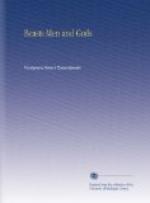“I do not like this temple. It is new, erected by the Lamas when the Living Buddha became blind. I do not find on the face of the golden Buddha either tears, hopes, distress or thanks of the people. They have not yet had time to leave these traces on the face of the god. We shall go now to the old Shrine of Prophecies.”
This was a small building, blackened with age and resembling a tower with a plain round roof. The doors stood open. At both sides of the door were prayer wheels ready to be spun; over it a slab of copper with the signs of the zodiac. Inside two monks, who were intoning the sacred sutras, did not lift their eyes as we entered. The General approached them and said:
“Cast the dice for the number of my days!”
The priests brought two bowls with many dice therein and rolled them out on their low table. The Baron looked and reckoned with them the sum before he spoke:
“One hundred thirty! Again one hundred thirty!”
Approaching the altar carrying an ancient stone statue of Buddha brought all the way from India, he again prayed. As day dawned, we wandered out through the monastery, visited all the temples and shrines, the museum of the medical school, the astrological tower and then the court where the Bandi and young Lamas have their daily morning wrestling exercises. In other places the Lamas were practising with the bow and arrow. Some of the higher Lamas feasted us with hot mutton, tea and wild onions. After we returned to the yurta I tried to sleep but in vain. Too many different questions were troubling me. “Where am I? In what epoch am I living?” I knew not but I dimly felt the unseen touch of some great idea, some enormous plan, some indescribable human woe.
After our noon meal the General said he wanted to introduce me to the Living Buddha. It is so difficult to secure audience with the Living Buddha that I was very glad to have this opportunity offered me. Our auto soon drew up at the gate of the red and white striped wall surrounding the palace of the god. Two hundred Lamas in yellow and red robes rushed to greet the arriving “Chiang Chun,” General, with the low-toned, respectful whisper “Khan! God of War!” As a regiment of formal ushers they led us to a spacious great hall softened by its semi-darkness. Heavy carved doors opened to the interior parts of the palace. In the depths of the hall stood a dais with the throne covered with yellow silk cushions. The back of the throne was red inside a gold framing; at either side stood yellow silk screens set in highly ornamented frames of black Chinese wood; while against the walls at either side of the throne stood glass cases filled with varied objects from China, Japan, India and Russia. I noticed also among them a pair of exquisite Marquis and Marquises in the fine porcelain of Sevres. Before the throne stood a long, low table at which eight noble Mongols were seated, their chairman, a highly esteemed old man with a clever, energetic face and with large penetrating eyes. His appearance reminded me of the authentic wooden images of the Buddhist holymen with eyes of precious stones which I saw at the Tokyo Imperial Museum in the department devoted to Buddhism, where the Japanese show the ancient statues of Amida, Daunichi-Buddha, the Goddess Kwannon and the jolly old Hotei.




